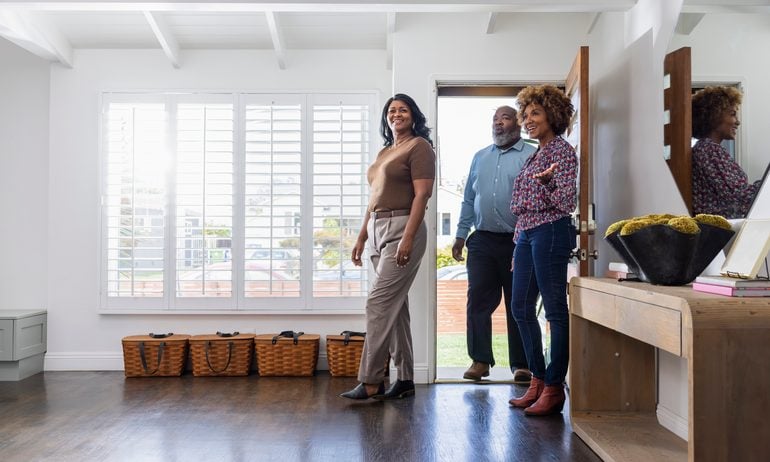Bridge Loans: What They Are and How They Work
A bridge loan may let you buy a new house before selling your old one. Bridge loans can have high interest rates, require 20% equity and work best in fast-moving markets.

Some or all of the mortgage lenders featured on our site are advertising partners of NerdWallet, but this does not influence our evaluations, lender star ratings or the order in which lenders are listed on the page. Our opinions are our own. Here is a list of our partners.
A bridge loan makes it possible to finance a new house before selling your current home. Bridge loans may give you an edge in a tight housing market, but they come with their own risks and restrictions.
Bridge loans at a glance:
You can typically borrow a maximum of 80% of the combined value of your current home and new home.
Six- to 12-month terms.
High interest rates and fees compared to conventional loans.
Best in areas where homes sell quickly.
» MORE: Calculate your home’s value
What is a bridge loan?
A bridge loan can give you the cash for a down payment on your next home before selling your current one. Without a bridge loan, you may be forced to make a contingent offer that depends on you selling your home before closing. A bridge loan can buy you additional time to sell your home if you find one you’d like to make an offer on first — and it can help you compete in a hot market, in which sellers may be unlikely to accept a contingent offer.

How bridge loans work
Bridge loans are generally used one of two ways: to pay off your current mortgage and make a down payment on your new house, or simply to make a down payment on the new house.
Both scenarios assume your old house sells, allowing you to pay off the bridge loan, plus interest, fairly quickly. If it doesn’t sell before the loan comes due, you may owe the full amount of the bridge loan on top of your new mortgage payment. This could lead to financial stress or even default.
Bridge loans usually must be paid off within six months to one year. Qualification requirements can vary by lender, but you’ll maximize your chances of approval by having a credit score of 700 or higher and a debt-to-income ratio below 50%. You can typically borrow up to 80% of the value of both properties combined.
Bridge loan pros and cons
Pros
You can make an offer on the house you want without a sale contingency.
With a down payment of 20% or more for your next home, you won’t have to pay for private mortgage insurance (PMI).
Cons
You'll pay high interest rates and APR for the bridge loan compared to a conventional mortgage.
You may have to pay for an appraisal on your current home along with closing costs and fees, which can cost thousands.
You may own two houses — with two mortgage payments — for a bit.
You're limited to a loan-to-value ratio of 80% on both properties, which may not be enough to cover your remaining mortgage balance and allow enough for a down payment.
Examples of when to use a bridge loan
If you find yourself in one of these sticky situations, a bridge loan might keep things on track.
Sellers in your area won’t accept contingent offers.
You can’t afford a down payment without the proceeds from your current house.
You’re confident your house will sell but prefer to secure a new home before listing it.
Closing on your current house is scheduled after the closing date for your new house.
Where to find a bridge loan lender
Like with any loan, you’ll want to compare offers and choose a reputable lender. Among lenders surveyed by NerdWallet in 2024, two specifically mentioned offering bridge loans: Northpointe and PrimeLending.
Bridge loan alternatives
Bridge loans aren’t your only option for buying and selling at the same time, and you may consider one of these alternatives depending on your plans.
Home equity line of credit: Known as a HELOC, this second mortgage lets you access home equity as a flexible line of credit with a variable interest rate. You’ll likely get a better interest rate and pay lower closing costs than with a bridge loan. You can’t get a HELOC on a home that’s for sale, so this option requires action in advance.
Home equity loan: This second mortgage is very similar to a HELOC, except that you receive the funds as one lump sum and pay it back at a fixed rate.
80-10-10 loan: If you have some cash on hand, this option may allow you to buy your next house with less than 20% down but still avoid private mortgage insurance. With an 80-10-10 loan, you get a first mortgage for 80% of your new home’s price and a second mortgage for 10% of the price. Then, you make a 10% down payment. When your current home sells, you can use any excess to pay off the 10% second mortgage on the new one.
Personal loan: While personal loans usually come with higher interest rates than home equity options, they also don’t have to be paid off right away after your home sells because they aren’t tied to your property.

